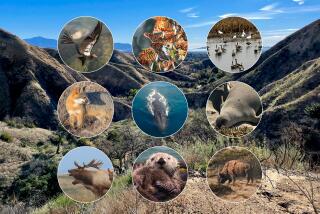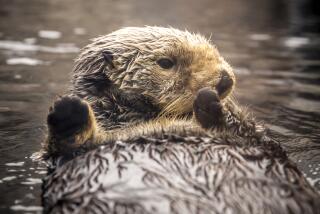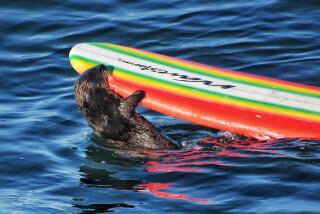California Sea Otterâs Life-and-Death Struggles : Infant Mortality, Oil Spills Threaten Ocean Mammals
MONTEREY â It is late afternoon on Fishermanâs Wharf in Monterey harbor and two tourists with a Midwest sound to their voices stand on a narrow expanse of planking behind Abalonettiâs Restaurant, joining an off-duty waitress watching two brown blobs floating in the water below.
Even to the uninitiated, the shapes are easily recognizable as a female sea otter and her newborn pup. The mother otter swims, floats, dives and feeds close by the pup, returning to the surface often with fish apparently filched nearby.
Every so often, she reaches out with her mouth to bring her pup close as she floats, characteristically lying on her back, with the meal spread out on her abdomen. Dutifully, she repulses marauding gulls attempting to steal her food and harass her young.
On this afternoon, with no fewer than 11 sea otters resting, feeding and playing within view of the wharf, it does not take long for spectators to notice that there is something terribly wrong with the otterâs display of parental affection.
The pup is not moving and, when binoculars are brought into play, it can be seen that the little creatureâs face is in the water. The female otter is fastidiously caring for a dead child, behavior that is not uncommon among this mammalian species.
Mounting Concern
Why otter pups die is unclear, but the mortality of the young is partly responsible for concern over the otterâs continuing viability--concern that has been building almost continuously since 1976 when the endangered sea otter, which had recovered to 1,400 to 1,500 on the California coast, went into decline again. The population now numbers 1,200 to 1,300.
A female sea otter may care for a dead pup for as long as three weeks until the little carcass finally sinks--a development experts say often appears to profoundly confuse the mother.
About 18 hours after the scene was first observed here, this is precisely what happens. It is the following morning, with the mother and dead young still bobbing off Fishermanâs Wharf. The mother grabs her pup by the head, pulling it toward three or four other otters frolicking in the water just off a slender strip of beach next to the quay.
For half an hour or so she does this--observed this time not only by spectators, but also by Jack Ames, a California Department of Fish and Game sea-otter biologist who has spent more than 10 years studying the macabre question of how otters die. He concedes that while many otter deaths are understood, much is still unknown about the meld of factors that can kill them.
âWhat we know about the sea otter would fill a pretty good-sized book,â said Dr. Tom Williams, a veterinarian here who has spent 17 years of spare time studying otter biology. âWhat we donât know about the otter would fill a heckuva big building.â
Courting Otters
What is happening in the bay reinforces Williamsâ point. With Ames watching from shore through a powerful telephoto lens, the pup appears to slip beneath the surface for the last time. The mother pauses and swims away.
Poignant though the moment is, it is not what has drawn Amesâ attention. Through binoculars, he has noticed two other otters courting in shallow water. Otters generally are at ease within view of people, but even otters donât normally make love in public.
Yet with the pupâs death being played out less than 100 yards away, Ames notices that the territorial male otter and the passing female have begun to mate.
Having made clear his intentions, the male otter grabs the female by the nose, biting hard enough to draw blood and inflict deep wounds. In fact, the condition of such nose scars among older breeding female otters is a key way biologists can determine their ages. It has become more than a passing (though unresolved) concern that pollution-related infections of nose wounds may emerge as a cause of death in female otters of reproductive age.
Recently, said Marianne Riedman, director of otter research at the Monterey Bay Aquarium, scientists have begun to suspect that the female otter has the capacity to delay implantation of the fertilized egg in her uterus, thus affording her a measure of control over when she will give birth.
The aquarium is currently conducting a variety of otter studies, relying largely on observations by teams of volunteer observers.
Riedman noted that even the animalâs natural life span is unknown, though it is thought to be 15 to 20 years for females and about five years less for males.
It isnât known, either, how long the delay in implantation can be--or even, for sure, if the capability exists. Births are almost always of a single pup.
In fact, when the rare birth of twins occurred--the phenomenon has been witnessed just once, ironically by Ames--the mother made an instant decision, shoving one pup away to perish in the waves, selecting the other to survive.
âYou Can Hear Pups Cryingâ
âIn terms of the amount of care they get, otter pups are as close to a human child as any animal,â said Rachel Saunders, staff biologist to the group Friends of the Sea Otter. âThey (pups) can wiggle around a little bit at the surface, but thatâs it. Even a primate young can do more than a sea otter pup.
âThey (the pups) are at the total whim of whatever the ocean and the currents do. The mother is around, but when sheâs diving for food, theyâre just there alone. Itâs eerie. You walk along here at night and you can hear the pups crying. Itâs pitch black or thereâs a fog and you know, or you hope, that mother is just down getting a midnight snack and will be up shortly.â
To be sure, the sea otter has become a political controversy. Among the pivotal disputes joining politics and biology is whether the California otter is a species unto itself.
A half-dozen prominent otter biologists agreed, for instance, that the California sea otter is, for all intents and purposes, genetically the same as the otter off the coast of Alaska, where recovery has been far better than here, with the total population now thought to number about 16,000.
But the California otter enjoys special endangered-species protection by virtue of the legal assumption that it is slightly different genetically than its Alaska cousin--a difference that, biologists now agree, probably does not exist. Without the distinction, however, the California populationâs protection might be endangered.
The political struggle has diverted public attention from the animal itself and its way of life--even though sea otter researchers have been working continuously to shed new light on its existence.
The sea otter plays a unique role in its environment since, anatomically, it is more like a land mammal than creatures like seals, sea lions and porpoises. On the other hand, it is so adapted to its environment that it leaves the water far less often than seals, elephant seals and sea lions and may live out its entire life without ever coming ashore.
It is born at sea, unlike sea lions and seals, and it generally dies at sea. Yet the otter has no appreciable layer of fat below its skin and has nothing resembling the blubber that permits seals and sea lions to survive in cold water.
Otter society is surprisingly orderly. For the length of its California range, there is an invisible patchwork of territories--each about a half-mile square--with each territory occupied by a single breeding male. During the winter, territorial males join groups of other otters, called rafts, at the north and south ends of the range, returning each year to the same offshore territory whose boundary is determined in large degree by the growth of kelp.
Male otters without territories--most of them adolescent or young adults--continue to raft together, and female otters raft in groups of their own. Almost without exception, the segregation of the sexes is maintained in the rafts. Breeding females often leave when they are in estrus and may mate with any territorial male whose district they pass through.
Once pregnant, females leave the male behind, giving birth and rearing the young alone. A close bond continues between mother and pup until the pup is as much as seven months old.
The otter has only its fur to keep it warm, and the precise nature of that fur is only now being explored. Williams, who conducted his own study, recently concluded there are 300,000 hairs per square inch of otter, of which only the outer âguard furâ is visible to the observer. Beneath the guard fur is a dense layer of fur that insulates the otter by preventing its skin from getting wet. Otters spend a quarter or more of their time grooming.
Otter Fur Cleaners
The study of otter fur, Williams said, was undertaken at least in part to determine how to clean it--an inquiry necessitated by the constant danger of an oil spill in the California coastal zone. Death is almost certain for an otter if 20% or more of its fur is soiled with oil.
Complicating matters is a behavioral quirk that leads the otter to dive (normal dive depth range: 60 feet, with two-minute air supply) if it is oiled. Diving repeatedly, an oiled otter tries instinctively to clean itself--behavior that would make the task of human rescue teams vastly more difficult.
Two emergency otter cleaning stations--one near San Luis Obispo and one at the Monterey Bay Aquarium--have been designated, and oiled otters would be rushed there or cleaned wherever they could be hauled from the ocean. Confronted with the need for a cleaner that could be found anywhere in the otterâs range--a territory stretching from about Morro Bay to just north of Santa Cruz--Williams recently tested a variety of commercial detergents, concluding that Dawn dishwashing liquid is the otter-cleaner of choice.
Serious Predators
Otter males weigh in at about 75 pounds; females are about half that size. The otterâs rapid heartbeat--about 150 beats per minute--is necessary to maintain body temperature in cold ocean water, Williams said. The same metabolic needs mean the otter must eat food amounting to about 20% of its body weight each day.
This has led to some of the otterâs biggest problems. It is a talented predator, equipped with a jawbone of far greater density than equivalent-sized animals, a full mouth of sharp teeth and strong, powerful front legs and paws equipped with catlike retractable claws. As adorable as otters may seem, they are capable of very quick, very aggressive reaction to any perceived threat.
The otter is also the only non-primate known to have mastered tool use. Often, Williams said, otters keep the same small rock securely under their left front leg, ready for use either as a hammer to crack open shellfish, or as an anvil, placed on their abdomens, on which their prey is smashed.
Some otters have been known to use beer bottles as tools and at least one Monterey Bay otter developed a technique for tearing open aluminum soda cans when it determined that a species of small octopus could be found inside.
Learning what otters eat--and why--has been a key part of research conducted by Jim Estes, of the U.S. Fish and Wildlife Service and the UC Santa Cruz Institute of Marine Sciences. Estes and graduate students working under him have been noting otter feeding habits for several years, concluding, he said in an interview in Santa Cruz, that simply depicting the otter as an abalone predator ignores a far more complex reality.
In all likelihood, Estes said, before otters were harvested for their luxuriant fur in the 19th Century, abalone was comparatively scarce off California. With the otter out of the picture, the abalone thrived and a lucrative commercial fishery came into existence.
âCommercial shell fisheries in California are an artifact of the near extinction of the otter,â said Estes. âIf the otter had not been nearly wiped out, these fisheries--abalone and clam in California and Dungeness crab in Oregon and Washington--would never have developed. There would have been nothing there for people to exploit.
Unique Sea Creature
âThe sea otter is unique as a marine mammal, an otter and a carnivore . . . unique in an evolutionary and ecological sense. They are very different from any other otter (for instance the fresh water river otter) and any other marine mammal. We know that their lineage diverged 10 million to 15 million years ago and that, over time, they have become highly adapted to an aquatic existence.â
What Estes and his graduate students have concluded is that, when otters first repopulate a territory, they eat abalone and sea urchins almost exclusively. But as the bounty of such prey is reduced, the otters gravitate toward a system of distinct food tastes in which individual animals like different things.
Some otters continue to prey nearly entirely on abalone, prying smaller ones from cracks on the ocean floor. But other otters gravitate toward other shellfish and even finned fish. Riedman of the Monterey Bay Aquarium said there has been at least one documented episode of an otter eating two species of sea birds, grabbing them from under water, biting their heads off and dining on the feathered carcass.
The emergence of individual food tastes, Estes believes, may be related to perpetuation of the strongest attributes of the species. The genetically fittest otters, for instance, might be those who remain true to the abalone-sea urchin stereotype.
Furry Political Issue
The issue touches on politics since the otter remains a creature of controversy among fishermen--especially those who ply their trade in Californiaâs shrinking abalone industry. But, as Estes sees it, the food-preference issue is perhaps even more central to the otterâs present and future.
A lively debate revolves around whether Californiaâs otter population is stagnant in numbers--and shrinking slightly--because a natural balance has been achieved with the food supply in its current range or whether other factors are involved. Like so many questions about the otter, there is no clear answer to this one.
Estes, Riedman, Ames and other experts agreed the issue is controversial. Carol Fulton, executive director of Friends of the Sea Otter, and Saunders are among those who contend that the otterâs problems since 1976 have been due to massive drownings in gill and trammel nets used by coastal fishermen--a practice outlawed two years ago. In the last 12 months, the number of known otter deaths along the coast--measured in terms of dead otters washed up on shore and other witnessed deaths--dropped from 72 in the first six months of 1984 to just 16 in the same period last year.
Scouring beaches for more than a decade, the Department of Fish and Gameâs Jack Ames has found the greatest mystery about the otter to be its demise. In fact, he said, in as many as 80% of these cases, the cause of death cannot be determined.
Drowning in fishing nets and gunshot wounds are commonplace, Ames said, but shootings are few and drownings accounted for just 18% of the 70 deaths known to have occurred last year.
One spectacular cause of death among otters, said Ames and Riedman, comes in attacks by great white sharks, another little-understood phenomenon. Dead otters with shark-tooth marks tend not to be chewed to pieces, Ames said. Though such an attack has not been witnessed, evidence suggests the shark grabs the swimming otter for a split second during an initial run, intending to leave it wounded and bleeding so it will lose consciousness. The sharkâs intent, Ames said, is to return and eat the prey after it passes out.
No Explanation
But there is no indication that the sharks actually return to eat otters they have mortally injured. âI donât know what happens,â Ames said. âThey (sharks) eat animals much bigger than an otter. Perhaps the first strike knocks the otter far away from where the shark is.â
Ames said he has no explanation for the otter deaths not accounted for by shooting, drowning and shark bite. Estes and Ames say that in otter populations that are struggling to re-establish themselves, death patterns seem to be different than in more prosperous ones. In reestablishing otter groups, deaths are most plentiful in older animals who appear to starve after their teeth wear down to the point that they can no longer effectively hunt.
Once otters become firmly established in a new range, deaths seem to be more common in juvenile animals--perhaps as a means of naturally controlling the demand for food and reproductive system of the individuals who remain.
More to Read
Sign up for Essential California
The most important California stories and recommendations in your inbox every morning.
You may occasionally receive promotional content from the Los Angeles Times.










